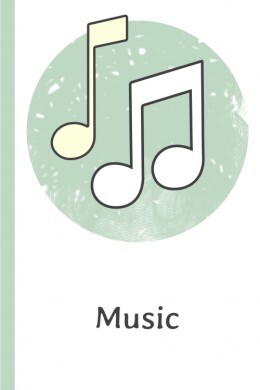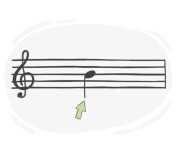Muzică - Notație muzicală
Aici vei învăța câteva cuvinte în engleză legate de notația muzicală, cum ar fi "diez", "fermata" și "glissando".
Revizuire
Fișe de studiu
Ortografie
Chestionar


notă întreagă
Pianistul a cântat o notă întreagă cu mâna stângă în timp ce împodobea melodia cu mâna dreaptă.

tonalitate
Compozitorul a ales tonalitatea sol major pentru simfonie, subliniind calitățile sale luminoase și înălțătoare.

do-ul central
Melodia începe cu do-ul de mijloc, oferind un punct de plecare stabil pentru piesă.

becar
Muzicianul a adăugat un becar notei F pentru a o readuce la înălțimea sa originală după ce a fost anterior mărită.

octavă
Pianistul a cântat o gamă care acoperea o octavă completă.

acord
Chitaristul a cântat un acord de sol major pentru a începe cântecul.

diez
Compozitorul a inclus un diez înaintea notei F pentru a indica că aceasta ar trebui să fie cântată cu un semiton mai sus.

notă albă
Melodia prezintă o serie de păsări, creând un ritm fluid pe parcursul întregii piese.

pătrime
Melodia începe cu o serie de pătrimi, stabilind modelul ritmic al piesei.

tonică
Piesa s-a încheiat pe tonică, oferindu-i un sentiment de finalitate și închidere.

linie de măsură
Compozitorul a trasat o linie de măsură pentru a marca sfârșitul fiecărei măsuri.

cheie
Partitura a fost marcată cu o cheie de sol la începutul portativului, indicând faptul că era destinată instrumentelor sau vocii cu tonuri mai înalte.

tablatură
A învățat să cânte melodia citind tablatura în loc de partitura tradițională.

optime
Melodia a prezentat o succesiune rapidă de optimi, creând o senzație de avânt în muzică.

șaisprezecime
Melodia a început cu o șaisprezecime, introducând un model ritmic rapid.

nota a douăzeci și doua
Secțiunea rapidă a piesei a prezentat un torent de treizeci și doime de notă, demonstrând virtuozitatea interpretului.

notă de șaizeci și patru
Pasajul rapid prezenta o cascadă de șaizeci și patruimi de notă, necesitând o mână precisă și agilă.

rază
Optimile erau unite printr-o singură bară.

timp comun
Dirijorul a semnalat orchestrei să înceapă să cânte în măsură comună, stabilind un ritm constant de patru timpi pe măsură.

ligatură
Pianistul a folosit o legatură pentru a conecta notele pasajului legato, creând o melodie fluidă și continuă.

sfert de ton
Compozitorul a încorporat sferturi de ton în melodie, creând un sunet unic și exotic.

semn de alterare
Accidentala ascuțită a crescut înălțimea notei cu un semiton.

arpegiu
În piesa de chitară clasică, muzicianul și-a demonstrat abilitățile cu un frumos arpegiu, evidențiind notele individuale ale acordului.

tril
Flautistul a executat un tril impecabil, adăugând ornamentație pasajului muzical.

valoare de notă
Compozitorul a atribuit cu grijă o valoare a notei fiecărei note, dictând durata și semnificația ritmică a acesteia în compoziție.












































